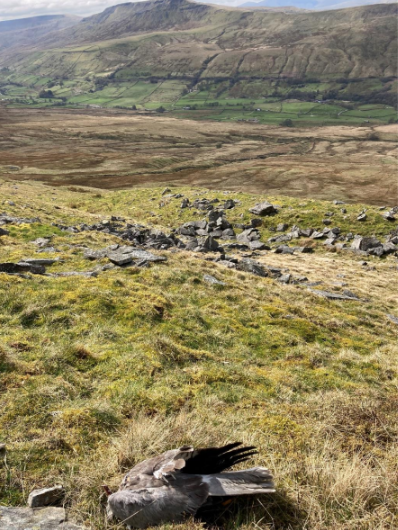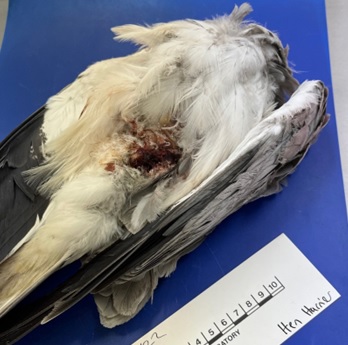Stephanie Bird-Halton, Director, National Delivery, Natural England
Hen harriers are currently extremely rare in England due to illegal persecution and nest disturbance, primarily in areas associated with grouse shooting. Natural England satellite-tracks hen harriers in order to investigate patterns of dispersal and survival, and the causes of any deaths. This blog is about Free, one of our tagged hen harriers, that died due to human persecution.
Free was hatched in 2020 from a nest in Cumbria, and in April 2022 he was two years old. At around this time, he had apparently settled in an area of moorland around Birkdale, near the border of Yorkshire and Cumbria. Our staff raised concerns when Free’s tag transmitted a signal late at night on 11 April 2022, indicating he was away from his normal roosting area.
As always, the police were immediately informed. It is not always possible to accurately identify the location of a satellite tag, as they do not transmit constantly, but in this case the tag was swiftly tracked down to a rocky slope above Outhgill. Free was found dead, headless and missing a leg, but showing no other sign of being eaten or scavenged by an animal predator, and still fitted with his satellite tag.

Free’s body was recovered and sent for post-mortem examination to diagnose signs of death. Shockingly and upsettingly, the post-mortem examination concluded that Free’s leg had been torn off while he was alive, and that the cause of death was the head being twisted and pulled off while the body was held tightly. These injuries would be consistent with Free being killed by human hands. There were no other signs of damage from any animal, and Free had not been shot.

The police and National Wildlife Crime Unit were kept informed, and no information has been shared publicly while enforcement action has been ongoing. Unfortunately, the police investigation did not gather sufficient information to identify a suspect. We are appalled and upset by this horrible death of a beautiful bird, but without further evidence the police and Natural England have no basis for further action. Any requests for more details about this case, or new evidence, should be directed to Cumbria police.
What next?
We are sickened by this evidence of persecution, which remains a serious issue and needs more focus and action from the police, businesses, landowners, and game management interests. We will continue our work tracking hen harriers and will make every effort to track down tags that stop transmitting, and to support the police in their role of bringing the perpetrators of these crimes to justice.
Natural England remains committed to working with our partners on hen harrier recovery. We are encouraged by the possibilities demonstrated by the recent increase in nesting hen harrier numbers overall, and will continue to work to turn the tide on the illegal persecution of these at-risk birds.
We regularly share the status of all our satellite-tracked Hen Harriers (every few months) on this page.
Acknowledgements:
We are grateful to our partners at the Zoological Society of London, the National Wildlife Crime Unit, North Yorkshire Police and Cumbria Police for their work on this investigation.
11 comments
Comment by D R Holmes posted on
No mention that the increase in numbers is mainly thanks to gamekeepers and the moor owners. A more balanced response would be more professional.
Comment by Richb posted on
You say that a “Slight increase in numbers” attributed to gamekeepers and moor owners hadn’t been mentioned but the species has simply been almost wiped out completely by gamekeepers and moor owners. Whatever small increase might have been achieved pales into insignificance I’m sure when you consider the years of persecution of the species on grouse moors. I’d hazard a guess that any slight increase from work carried out by gamekeepers and moor owners is as a result of pressure and campaigns , even funding from groups dedicated to saving the species.
Comment by R D Barber posted on
D R Holmes, are you seriously asking for the very people responsible for the enormous decrease in numbers of these birds, almost to the point of extinction, to be credited with a small increase in numbers now? Where is your sense of balance? How is “we are still killing these birds, just not quite so many” justifiable in your mind?
Comment by G Tansley posted on
Many gamekeepers kill hen harriers and also buzzards, red kites and golden eagles. Particularly on moorland areas with grouse shooting. That is indisputable. Personally ‘thanks’ is not high on my list of responses to gamekeepers and moor owners.
Comment by Alex Milne posted on
The fact that the vast majority of deaths of Hen Harriers occur on grouse moors is well researched. It is suggestive that gamekeepers and Moor owners are likely to be involved in the huge number of birds which die on these moors. There is little sign of a increase of Hen Harriers in England despite the large number of nests and a lesser number of hatched young.
Comment by Howard Fearn posted on
No mention that the perilous status of this species is mainly thanks to gamekeepers and the moor owners. A more balanced response would be more professional.
Comment by Ernie Scales posted on
Then demand of government that penalties be increased e.g. bird goes missing over a particular moor, ban on shooting.
Comment by Mike B D posted on
I believe that halting shoot licenses when birds of prey are found to have been destroyed on that land is the solution most likely to bring about change. Gamekeepers are under tremendous pressure to prevent the loss of quarry species and face the risk of losing their job and home if they fail to do so.
By addressing the root of the problem, this approach provides a strong incentive to discourage the destruction of birds of prey that pose a threat to the product. It would serve as a significant deterrent to human interference with protected species.
Comment by Thomas shanta posted on
I'm not sure we need to be thankful to gamekeepers or anyone for abiding to wildlife protection laws. It merely indicates/confirms what the primary cause of their reduced survival is often attributed to, as often our response is 'we can't say for sure' as we can't. Of course, I'm glad our work with them is appearing to have a positive impact on their English population and i hope it continues, it's brilliant, thou we should never be afraid of being truthful and transparent- we owe to the birds, ourselves and the public.
Comment by T Crabbe posted on
D R Holmes - Why would they mention who contributes to the increase in hen harrier numbers on an article that is about an individual bird, not the population as a whole?
The article is already impartial, your comment is the only biased thing here
Comment by John Butterfield posted on
Working with partners is fine if your "partners" are completely onside with your objectives. If they're not then it's "working with partners" that's the problem.